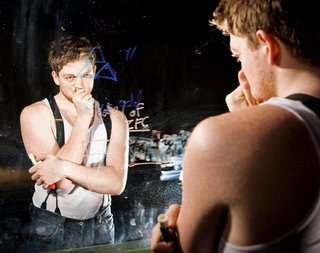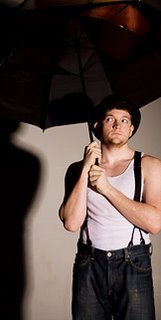Doing the math of being a clown.
a Princeton University math major who has also been studying clowning.
 Here’s a story from Princeton about a double major in math and theatre that is creating a one-man clown show. Or as he prefers to say a one-man show about a clown that is not a clown show .
Here’s a story from Princeton about a double major in math and theatre that is creating a one-man clown show. Or as he prefers to say a one-man show about a clown that is not a clown show .
(Thanks to Robin Izzo Scott, high school classmate, Facebook friend, and Princeton faculty/staff member for the heads up)
Posted April 22, 2009; 06:23 p.m. by Jennifer Greenstein Altmann
From the April 20, 2009, Princeton Weekly Bulletin
Senior Sam Zetumer likes to work in opposing realms.
He is a math major who is earning a certificate in theater and dance. He scribbles math equations on the chalkboard while waiting for rehearsals to begin. He currently is completing two senior theses: one on set theory, and one on clowning.
Zetumer enjoys immersing himself in two such different disciplines. Math requires him to “shut down external awareness,” he said, while theater asks “that I exist in this communal space.” Alternating from one to the other is “like going 60 and then going in reverse,” he explained.
Beginning Friday, April 24, Zetumer will perform his senior thesis production, titled “Good Winks Here,” a one-man show about a clown that is not a clown show — no juggling and no gags.
“It’s about a weird human being who’s struggling to find out how his world works and failing very badly at it,” Zetumer said. “It’s a style of clowning that’s all about vulnerability.”
Zetumer with umbrella
Zetumer said his show is “about a weird human being who’s struggling to find out how his world works and failing very badly at it. It’s a style of clowning that’s all about vulnerability.”
“Sam’s doing something very brave here — creating his own material and going out there, totally alone, to share his deep interest in clown work with an audience,” said Tim Vasen, a lecturer in theater and dance and the Lewis Center for the Arts who is one of Zetumer’s thesis advisers. “What he’s doing is, first of all, funny, and also sometimes haunting, like the best clowns in the Bill Irwin/Charlie Chaplin/Buster Keaton tradition always are.”
Vasen sees a common thread in Zetumer’s twin pursuits.
“He’s a systems nut — be it advanced math or physical technique,” he said. “Clown work is also a system, and what Sam’s doing in his rehearsals is playing with that system, testing it against the lights and chairs and umbrellas and floors and walls, almost like scientific research.”
Zetumer studied physical comedy last summer when he took courses on clowning technique offered by the Pig Iron Theatre Company in Philadelphia. The company describes itself as a dance-clown-theater ensemble that seeks to break the boundaries of dance, drama, clowning, puppetry, music and text. His summer with the troupe was supported by the Lewis Center’s Alex Adam ’07 Award, which Zetumer won last year. The award funds summer projects that lead to the creation of an original work of art.
Zetumer first worked with members of Pig Iron during his freshman year, when they taught a physical theater class at Princeton that included clowning. After graduation Zetumer will move to Philadelphia to work for Pig Iron as an assistant stage manager.
A native of San Diego, Zetumer was drawn to Princeton because of the University’s strengths in math and theater. For his other thesis, Zetumer is constructing a new version of set theory, which is an important foundational system for mathematics.
His adviser, Professor Edward Nelson, described Zetumer as “fiercely independent. He works hard on his own to resolve problems without asking for help.”
During his time at Princeton, Zetumer has appeared in several theatrical productions, portraying Prince Shuisky in Alexander Pushkin’s play “Boris Godunov” and performing in “The Winter’s Tale,” “All My Sons” and “Romeo and Juliet.” But for Zetumer, “Good Winks Here” promises to be his most memorable role.
The piece “is serious work, but it’s funny and touching,” said Vasen, who described Zetumer as “extremely creative” and unconstrained. “Sam has always followed his own muse.”


I'm very interested to know more. The article doesn't really tell me anything in detail about the connection between maths and clown. As a clown and a clown researcher, who many years ago used to love maths, I'm intrigued but not yet enlightened.
I'm very interested to know more. The article doesn't really tell me anything in detail about the connection between maths and clown. As a clown and a clown researcher, who many years ago used to love maths, I'm intrigued but not yet enlightened.